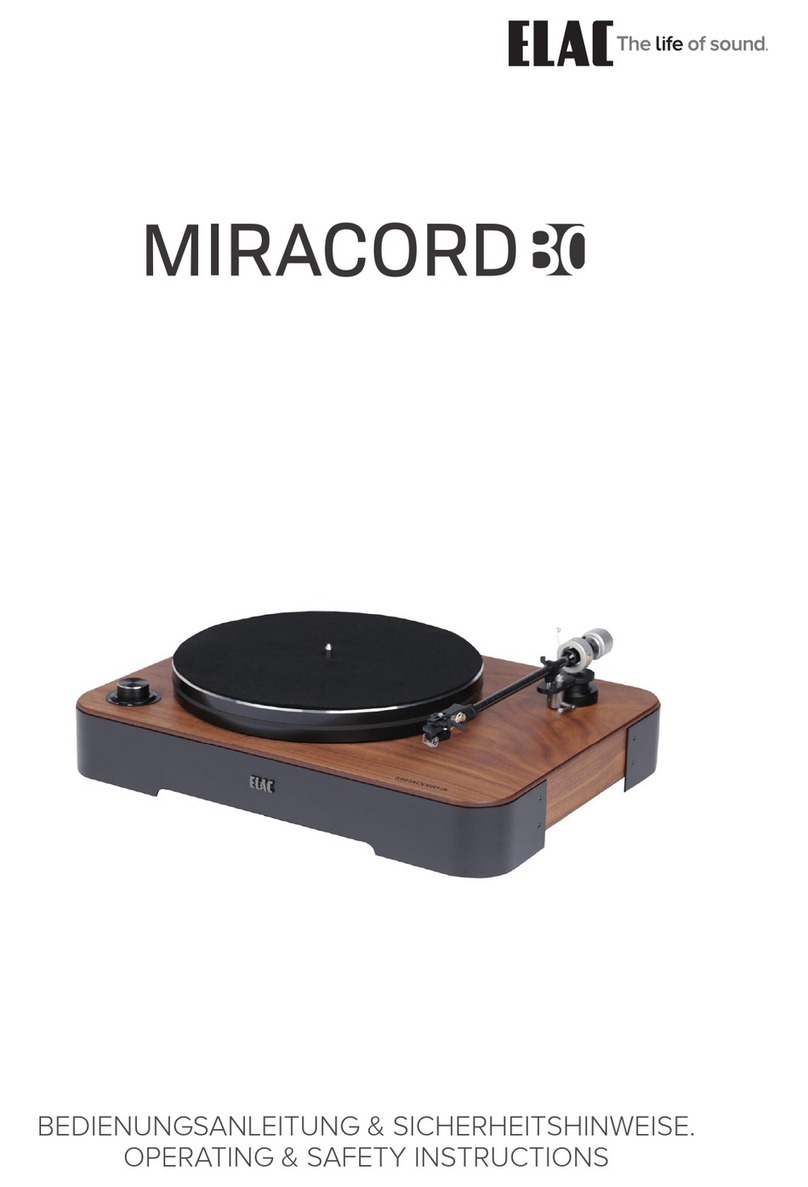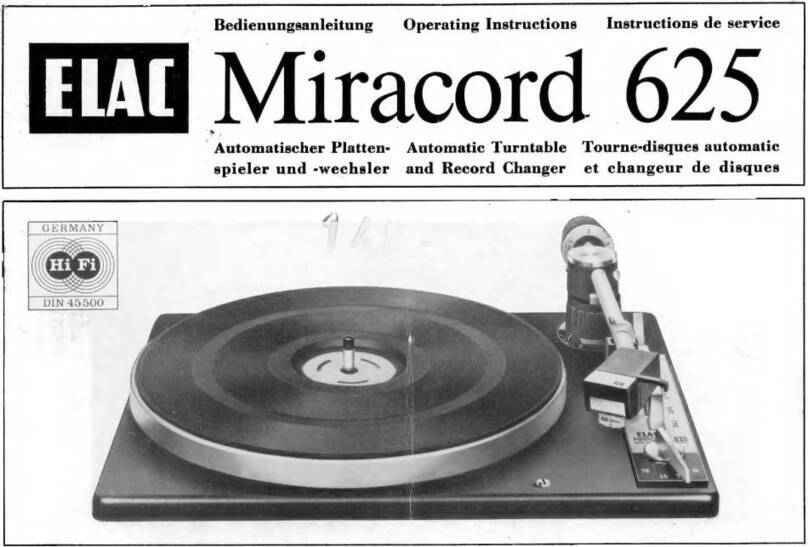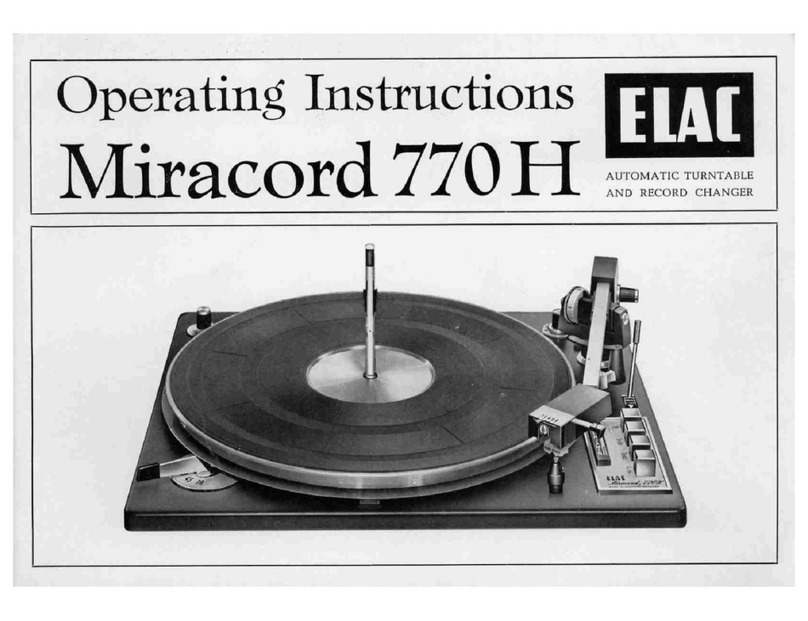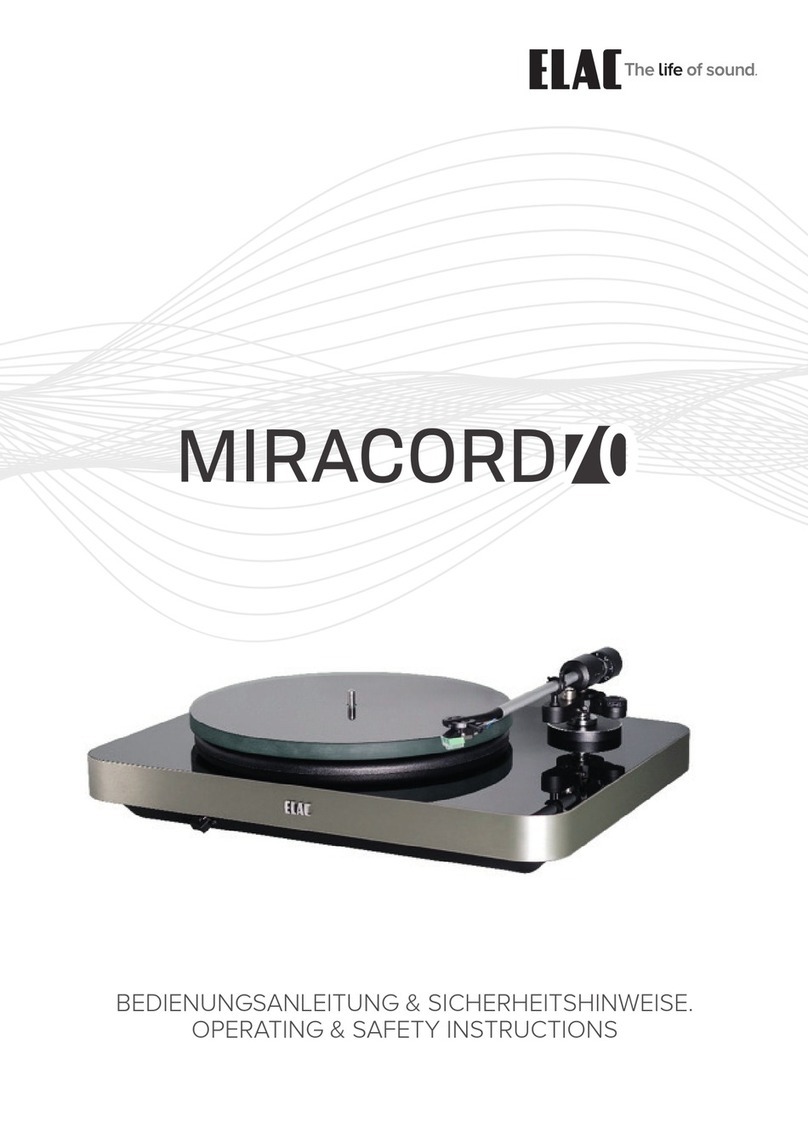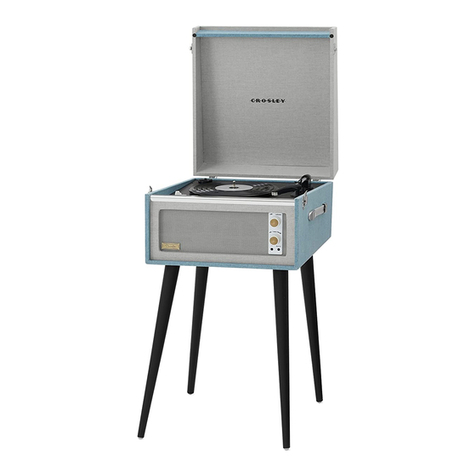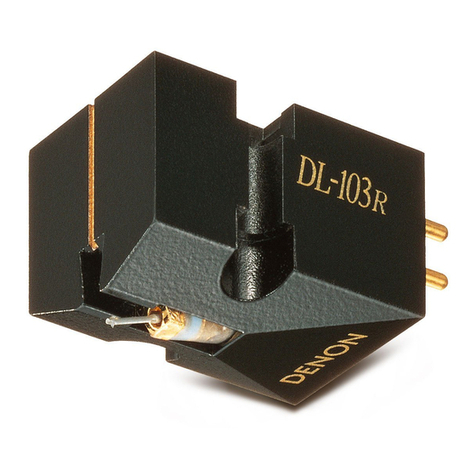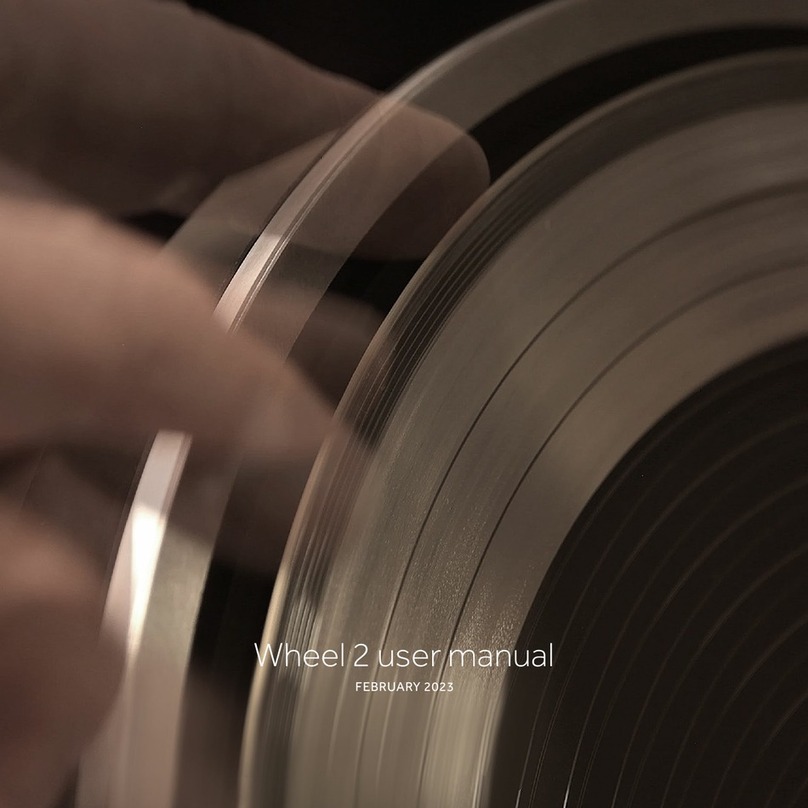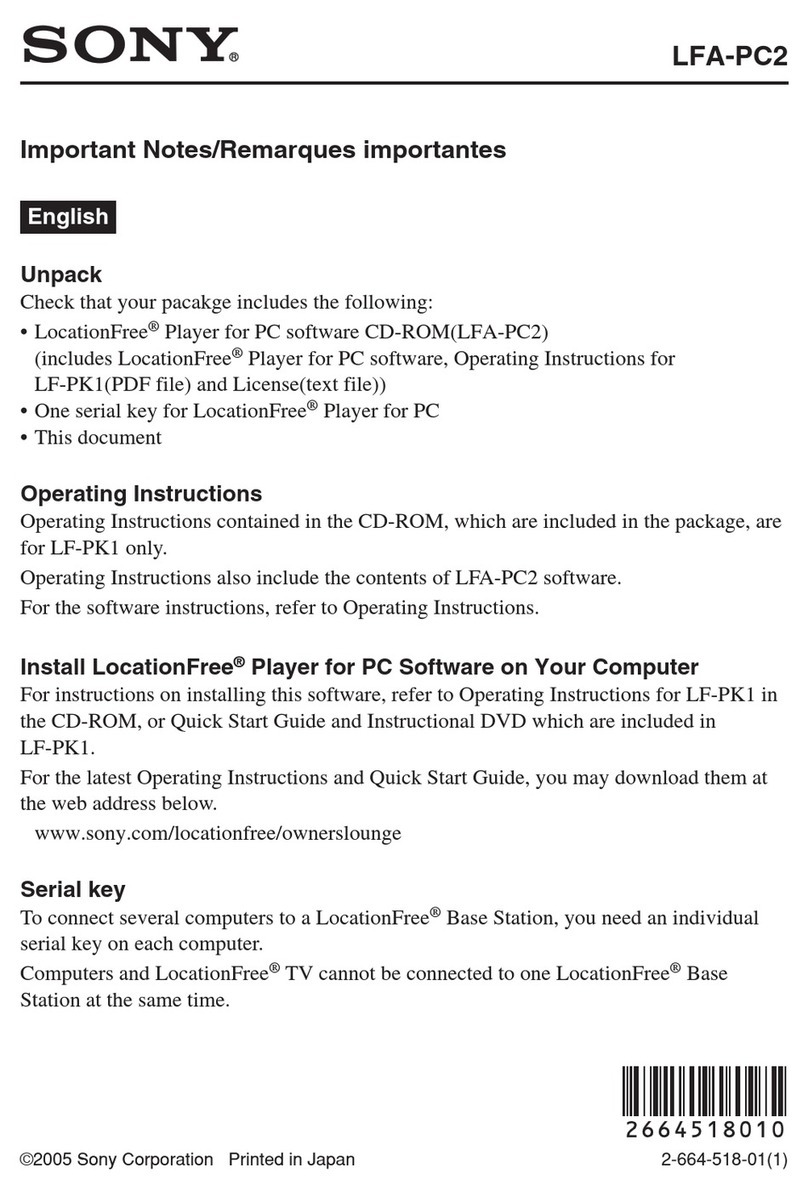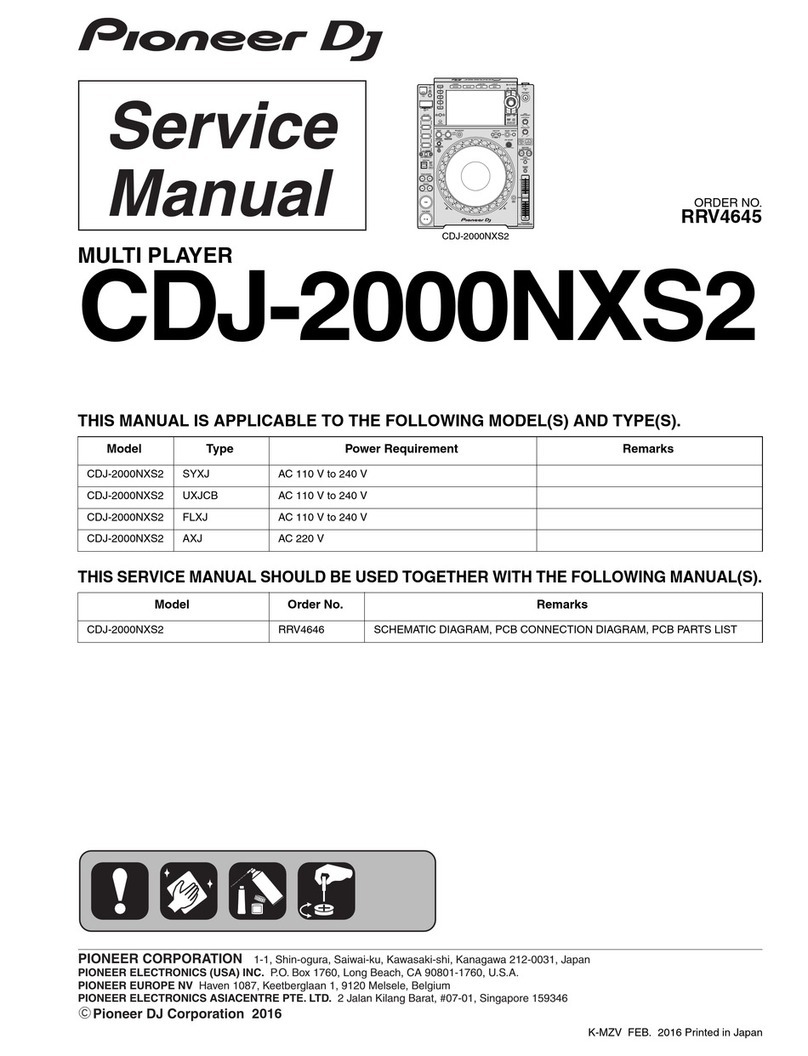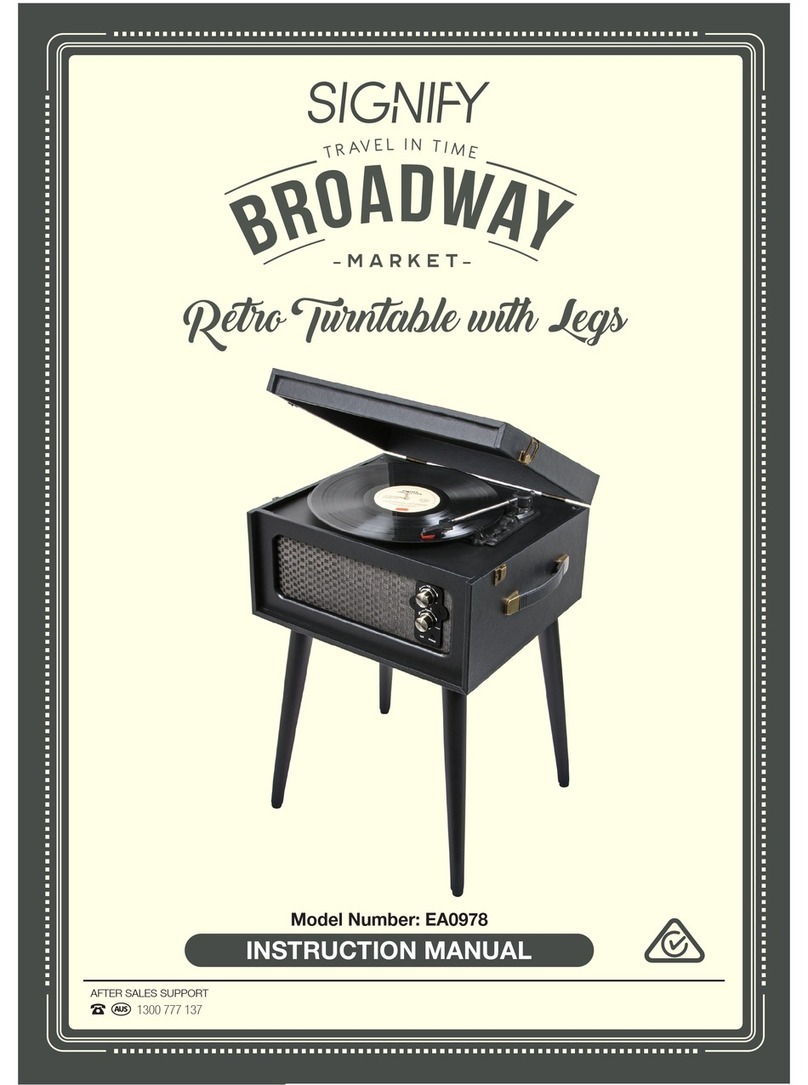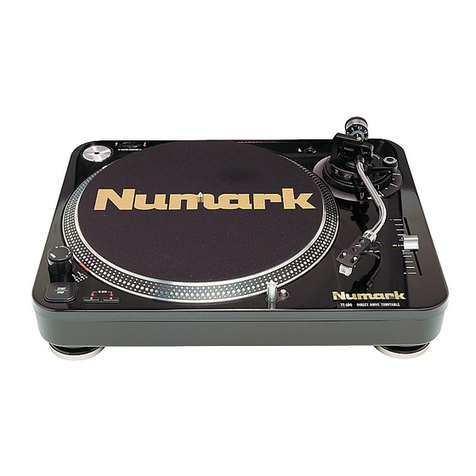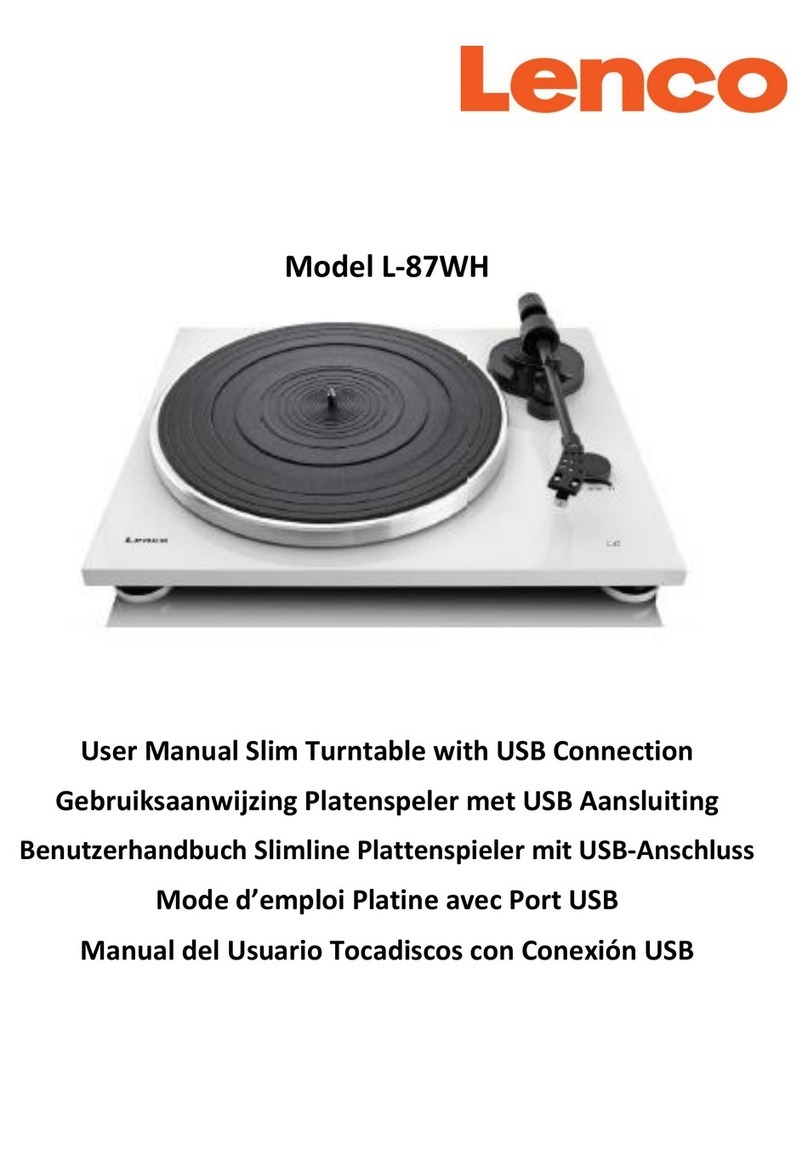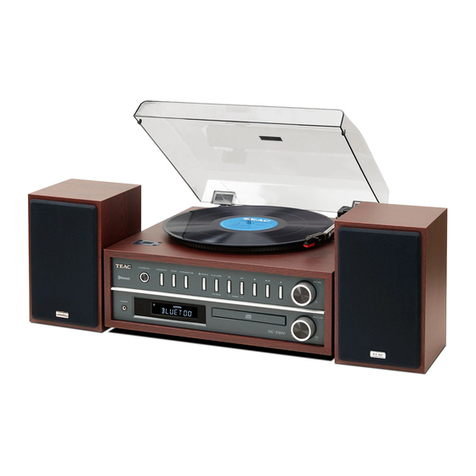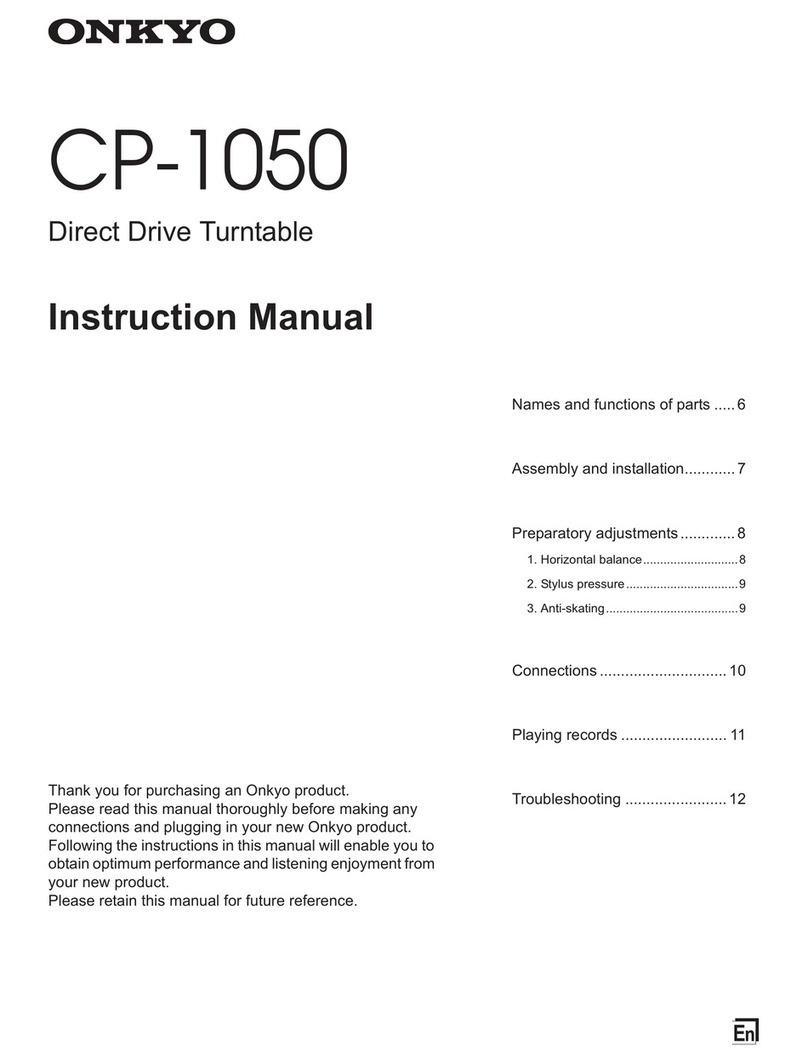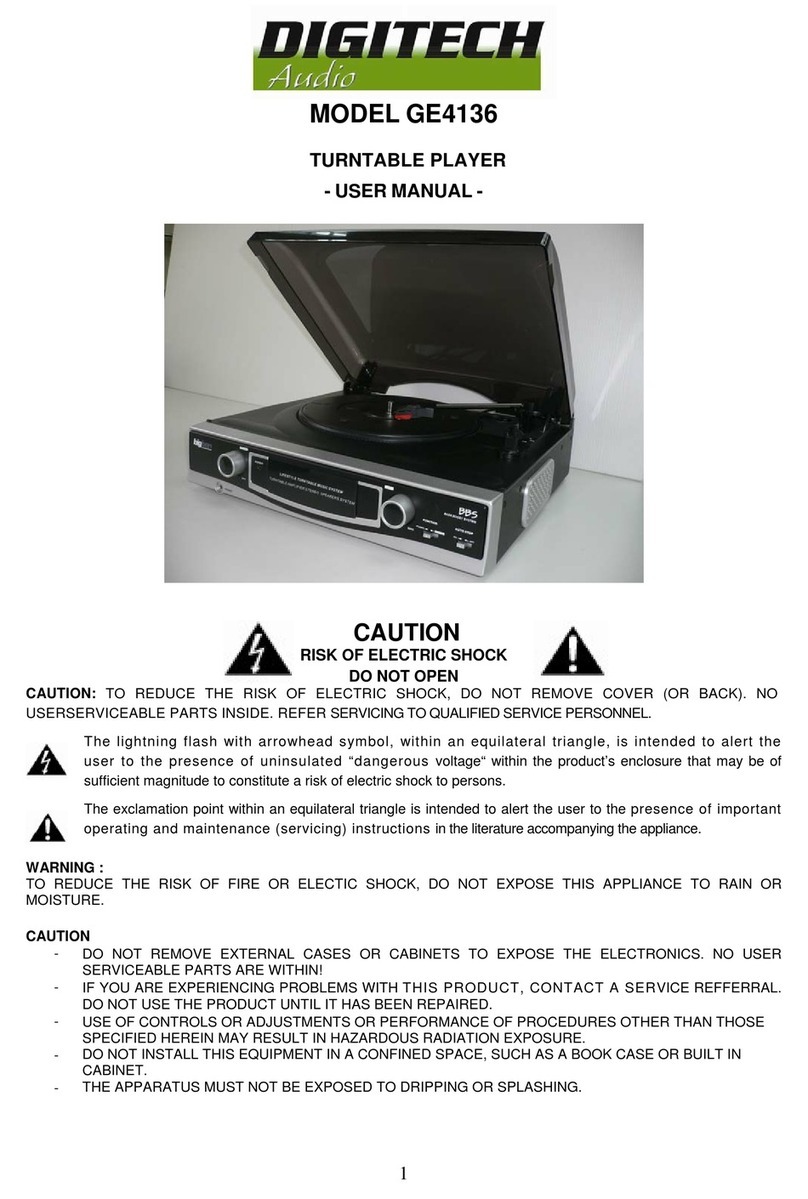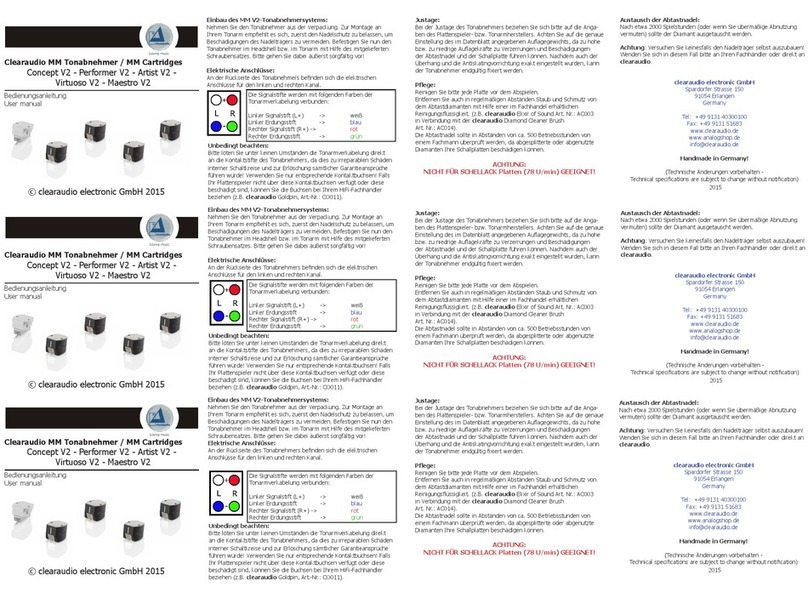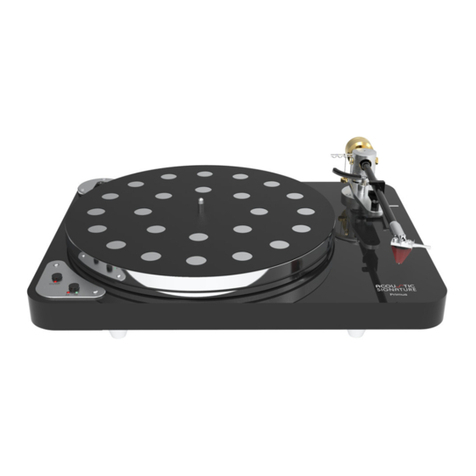ELAC Miracord 90 User manual

Miracord 90
Wir beglückwünschen Sie zum Kauf eines ELAC Plattenspielers, der unter strengen Qualitäts-
und Umweltauflagen hergestellt wurde. Um alle Leistungsmerkmale optimal auszunutzen, lesen
Sie bitte die Bedienungsanleitung gründlich durch. Wir raten Ihnen, diese Anleitung für späteres
Nachschlagen gut aufzubewahren.
Bitte beachten Sie die separaten Sicherheitshinweise, die der Verpackung Ihres neuen Plat-
tenspielers beigepackt sind. Bitte lesen, beachten und befolgen Sie alle diese Sicherheitshin-
weise und bewahren Sie diese ebenfalls auf. Beachten Sie alle Warnungen, die auf dem Gerät
und in der Bedienungsanleitung aufgeführt sind.
Congratulations on the purchase of your ELAC turntable that has been designed in accordance
with strict quality and environmental requirements. Please read the instruction manual carefully.
We recommend keeping it in a safe place for future reference. Please note the enclosed
safety instructions. Please follow the instructions and keep the safety instructions. Heed all warn-
ings on the appliance and in the manual.
Bedienungsanleitung
Operating Instructions

Inhaltsverzeichnis / Contents 2
Seite
page
Deutsch
Lieferumfang 3
Einführung / Allgemeines 4
Vorbereitungen zur Inbetriebnahme 5
Kurzbeschreibung der Bedien- und Anschlusselemente 6
Störungshilfen 7
Service / Pflege / Fertigungskontrolle / Lautsprecherentsorgung / Recycling 8
Gewährleistung / Werksgarantie 9
Technische Daten 16
English
Scope of delivery 10
Introduction / General 11
Preparation for operation 12
Connections and controls 13
Troubleshooting / Warranty 14
Production control / Disposal / Recycling 15
Specifications 16

Scope of delivery 10
Position Pcs. Description
A 1 Turntable chassis
B 1 Platter with felt mat
C 1 Belt in carton box
D 1 Tone arm counter weight
E 1 Anti-skating weight
F 1 Power supply adaptor
G 1 Mains cable
H 2 Instruction manual / Safety instructions
I 1 Audio cable (RCA)

Introduction / General 11
What is so special with ELAC Miracord 90?
The massive aluminum platter with a mass of almost 6.5 kg (!!!) rests
on a sub platter which is equipped with a hardened steel axis rotating
on an 8 mm ruby ball.
The two axial bearings are made of sintered bronze.
The Miracord 90’s frame is made of 5.5 kg solid MDF which is
characterized by a high inner damping. This eliminates high
frequency vibrations efficiently. What is more, thanks to the newly
developed silicone rubber feet the chassis is decoupled from the
surface
Thanks to the rubber dampers and fabric centering devices which are
well-known from speaker design the motor is decoupled from the
chassis (and also from the tone arm) twice.
The tone arm is made in Germany and was especially developed for
this turntable. The arm is made of an ultra-light carbon pipe, the rest
of the parts is made of aluminum and brass.
The so called coreless DC motor is controlled by a microcontroller in
which a PID regulator is taking care of the correct speed. The
detection of the current speed is done optically on the bottom side of
the platter.
The variable pitch control allows a variation of the speed up to +/- 5
%.
The connection is done via gold plated RCA jacks and a ground
screw. The connection to the external power supply is done via a
lockable Lumberg connector.
The turntable is shipped in working order, i.e. a high grade Micro Line
Cut pickup system especially made for ELAC by Audio Technica is
also integrated.

Preparation for operation 12
Before the turntable can be used some preliminary activities have to be put into effect.
1.1 How to install the platter (B):
The platter has to be positioned in perfect alignment to the sub platter. Settle down the platter carefully
without tilting it. The platter should lie flush on all 4 rubber bumpers of the sub platter. Turn the platter
clockwise carefully to see that there’s no radial runout.
1.2 How to install the belt (C):
Take the belt out of the beauty carton and put it circumferential around the platter. Now pull the belt in
direction of the motor and pull it over the motor pulley. Check if the belt runs centered on the pulley by
carefully turning the platter clockwise. That should be the case after 2 turns at the latest.
1.3 How to install the tone arm weight (D) on the tonearm:
Place the tone arm weight onto the thread of the tone arm and turn it clockwise
until the tone arm is floating. Check this by carefully releasing the tone arm
from time to time while turning.
If the tone arm isn’t spreading up anymore the floating point has been reached.
If the tone arm is spreading down the weight has been turned too wide and
should be turned back counterclockwise a bit.
1.4 How to adjust the tracking force:
From the floating point turn the weight clockwise onto the thread exactly 3 ½
turns. This results in a tracking force of appr. 1.4 g. The tone arm is now ad-
justed properly.
1.5 Installing the anti-skating weight (E):
The anti-skating weight should be installed as shown on the picture above.
1.6 Putting-on the felt mat:
The last step is to put the felt mat onto the platter if not done already.
The turntable is ready for use now and can be connected.

Connections and controls 13
2.1 Connecting the audio outputs:
The two RCA jacks are directly connected to the pick-up system. So
you need a (pre-) amplifier with phono input or an additional phono
preamp.
Next to the output jacks there is the earth connector which is con-
nected to all metal parts of the turntable. This screw can be used for potential equalization with the con-
nected (phono-) preamp. Sometimes it’s also useful for getting rid of humming problems. Preferably
you should use the audio cable (I) which is part of the accessory kit. The optimum signal flow direction
is marked by an arrow on the cable.
2.2 Connecting the power supply:
On the rear side of the turntable you can find the Lumberg power sup-
ply jack. Please connect the power supply adaptor (F) which comes
with the turntable here. The power supply adaptor should be con-
nected to the mains with the power cord (G) which also comes with
the turntable.
2.3 Turning on the motor / choosing the speed:
The control wheel includes two different functions. On the one hand, the motor will be
started and thus the desired speed will be chosen by turning the outer rotary switch
either to 33 rpm or to 45 rpm. On the other hand, the pitch can be fine-adjusted within
a range of +/- 5 % by using the inner pitch wheel (potentiometer).
Please make sure, the pitch wheel is adjusted to middle position first (center detent).
You can now turn on the motor by selecting either „45 Upm“ or „33 Upm“.
While the motor is slowly increasing speed the indicator LED in the control wheel is
glowing green (= nominal speed not reached).
As soon as the desired speed is reached the LED glows white permanently.
Remark: Because of its high weight the platter reacts very slowly on speed changes
which are provided by the speed regulator. So, the LED might change color between
“green-white” (current speed value below desired speed), “white” (current speed = de-
sired speed) and “red-white” (current speed above desired speed) before the LED per-
manently glows white.
2.4 Pitch wheel:
The pitch wheel allows the user to fine-adjust the speed in a range of
+/- 5 %. The middle position provides center detent.
Remark: The control LED acts as your „independent expert” and moni-
tors the deviation to the nominal speed permanently. If e.g. “45” is se-
lected a deviation below the nominal speed will be displayed as „green-
white“, a deviation above nominal speed will be displayed as „red-
white“. This is also relevant for the case that you intentionally increase
or decrease the speed with the pitch wheel.

Troubleshooting / Warranty
14
Warranty
The terms of warranty are regulated individually by the law in the different countries and by the terms of
the international ELAC representatives respectively. If you have not bought your appliance in Germany,
please check the terms with your retailer. Warranty can be given by any special retailer who has been
authorized by ELAC or the respective international representative to distribute ELAC products (EU con-
tract retailers). In the case of warranty, the complete appliance together with the receipt has to be handed
over to the retailer.
Symptom Possible root cause Remedy
Motor doesn’t work
No connection to the mains
or mains fuse burnt through Check mains plug, receptacle and fuse.
Power supply not connected
properly
Check the Lumberg plug for correct fit and
fix it.
Rotary switch in position „0“ Switch the rotary switch to either „33 Upm“
or „45 Upm“.
Audio signals are re-
produced distorted or
not loud enough, even
if volume is turned to
max. on (pre-) amp
(pre-) amp doesn’t have
enough gain
Make sure the preamplifier which is con-
nected to the turntable provides a suitable
input and a RIAA equalization. If applicable
a phono preamp has to be connected in ad-
vance.
(pre-) amp is misadapted
Use the option „Moving Magnet“ for the
phono preamp and the input impedance of
47 kOhm.
The right channel ap-
pears on left channel
and vice versa
The channels are swapped
Swap the two RCA plugs (left and right
channel) which are plugged into the turnta-
ble’s RCA jacks.
Loud humming noise
Contact problems with the
signal connections (e.g. RCA
plugs, RCA extensions or
adapters)
Check all connections; for acoustical check
relating major problems reduce the amp’s
volume level to minimum. Possibly the RCA
plugs ground rings should be re-adjusted.
Gentle humming noise Metal housing acts as an-
tenna and catches humming
In certain cases it makes sense to connect
the metal parts of the turntable to signal
ground of the (phono-) preamp. On the rear
side of the turntable there’s an earthing
screw for this purpose. Please use a wire
with enough cross section for this ground
connection.
The music doesn’t
sound naturally Wrong speed selected
Check which speed has to be chosen for
playing the current record. There are also
records on the market which have the same
diameter as a LP (30 cm) but have to be
played with 45 rpm (e.g. maxi singles). On
the other hand there are also records in sin-
gle format (17 cm) which have to be played
with 33 rpm (so called “EPs”).

Production control / Disposal / Recycling 15
Your turntable is maintenance-free. Changes in acoustical behaviour decrease over the years so that the
human ear will probably change even more than the turntable actually does. Only the needle should be
checked from time to time and should eventually be replaced.
Clean your turntable only with a soft, dry and smooth cloth,
or with a dust brush. Do not use scouring powder, alcohol, benzene, French polish,
or other agents. Do not expose your turntable to a relatively high humidity. Tempera-
ture variations, humidity and excessive sunlight may damage the turntable and result
in optical changes.
In the case of malfunction of your turntable apply to an expert. Your special dealer will
be pleased to help you. If a turntable should be destroyed through improper use by a
second person the repair requires special know-how in order to provide accurate per-
formance of your device.
Many of today’s modern furniture are coated with multiple varnishes and plastics which may be treated
with chemical agents. Some of these agents might contain substances which cauterize or soften the
rubber feet. Therefore, we would like to advise you to place an anti-slip mat underneath the turntable.
Production Control
Every production step is controlled individually. Each part of the turntable (e.g. electronics unit or motor)
is tested several times, from the purchase until the final assembly. In the final control every turntable is
tested acoustically, i.e. skilled ears check the acoustic quality of each frequency range.
To be able to observe the tolerance limits, variations e.g. the values of the electric components must be
severely restricted, since inaccuracies of single components may add up in the total system. To achieve
maximum production quality, compliance with ELAC quality criteria and guidelines can be regarded as
the most important duty.
Turntable Disposal
Please keep the cardboard box and packaging. Since the box and packaging represent the ideal con-
tainer for the appliance, you should keep them for future transports.
Material-Specific Disposal
If you want to discard the packaging, please do not put it in the household waste, since here it will be
mixed up with other residual materials. Please, do not give the material to collecting points for paper or
other materials, but take it to the dealer's. The packaging represents an important recoverable material.
It consists of fabric, PE (bag and packing parts) as well as cardboard, which should be returned to the
material resources cycle for recycling. We have an agreement with your special dealer to take back and
dispose of the material in a way that guarantees material-specific disposal. Thus, please, take the pack-
aging back to your dealer for disposal.
Recycling
Support the environmentally-friendly disposal of electronic industry waste.
Old electronic and electrical appliances must not be disposed of in the same manner as reg-
ular household waste!
Environmentally-friendly recycling must take place according to each country’s regulations.

Technische Daten / Specifications 16
Dimensions H x W x D 170 x 470 x 360 mm
Weight 17.1 kg
Pick-up system Moving Magnet system by Audio Technica
Frequency range 20 Hz … 25 kHz
Tracking force 1.4 +/- 0.4 g; 14 +/- 4 mN
DC resistance 800 Ohms +/- 20 %
Coil impedance 3.2 kOhms +/- 20 % @ 1 kHz
Recommended load resistance 47 kOhms
Output voltage 2.2 – 4.9 mV
Crosstalk damping > 25 dB
Nominal speed 33 / 45 rpm
Pitch +/- 5 %
Outputs 2 Neutrik RCA jacks, gold plated; 1 grounding screw,
gold plated
Power supply 18 V / 18 W with Lumberg plug
Colors Black Highgloss, White Highgloss, Walnut Oiled
Technische Änderungen und Designänderungen vorbehalten / Technical data are subject to change.
ELAC Electroacustic GmbH
Fraunhoferstrasse 16, 24118 Kiel
Tel. 0431/64 774-0, Fax 0431/682101
www.elac.de
02 1005 5284
150347
Table of contents
Other ELAC Turntable manuals
